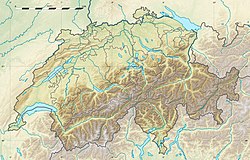Glarus thrust
Sardona | |
|---|---|
| Criteria | Natural: (viii) |
| Reference | 1179 |
| Inscription | 2008 (32nd Session) |
| Website | www |
| Coordinates | 46°55′N 9°15′E / 46.917°N 9.250°E |
The Glarus thrust (German: Glarner Überschiebung) is a major thrust fault in the Alps of eastern Switzerland. Along the thrust the Helvetic nappes were thrust more than 100 km to the north over the external Aarmassif and Infrahelvetic complex. The thrust forms the contact between older (Helvetic) Permo-Triassic rock layers of the Verrucano group and younger (external) Jurassic and Cretaceous limestones and Paleogene flysch and molasse.
The Glarus thrust
World Heritage
Thrust faults of this kind are not uncommon in many mountain chains around the world, but the Glarus thrust is a well accessible example and has as such played an important role in the development of
In 2006 the
The American Museum of Natural History in New York exposes a full-scale reconstruction of the Glarus thrust.[2]


History
The first
Escher's successor as professor at Zürich,
At the turn of the century, Heim was also convinced of the new theory. He and other Swiss geologists now started mapping the nappes of Switzerland in more detail. From that moment on, geologists began recognizing large thrusts in many mountain chains around the world.However, it was still not understood where the huge forces that moved the nappes came from. Only with the arrival of
Notes and references
- ^ Swiss Tectonic Arena Sardona – UNESCO World Heritage Centre
- ^ geopark association Archived 2011-07-26 at the Wayback Machine
- ^ Bertrand, M. (1884). "Rapports de structure des Alpes de Glaris et du bassin houiller du Nord". Société Géologique de France Bulletin. 3rd. 12: 318–330.
- .
- ^ Schardt, H. (1893). "Sur l'origine des Préalpes romandes". Eclogae geologicae Helvetiae. 4: 129–142.
Literature
- Franks, Sibylle; Rudolf Trümpy (September 2005). "The Sixth International Geological Congress: Zürich, 1894" (PDF). Journal of International Geoscience. Episodes. 28 (3). International Union of Geological sciences: 187–192. Archived from the original (PDF) on 2011-09-28. Retrieved 2008-07-10.



